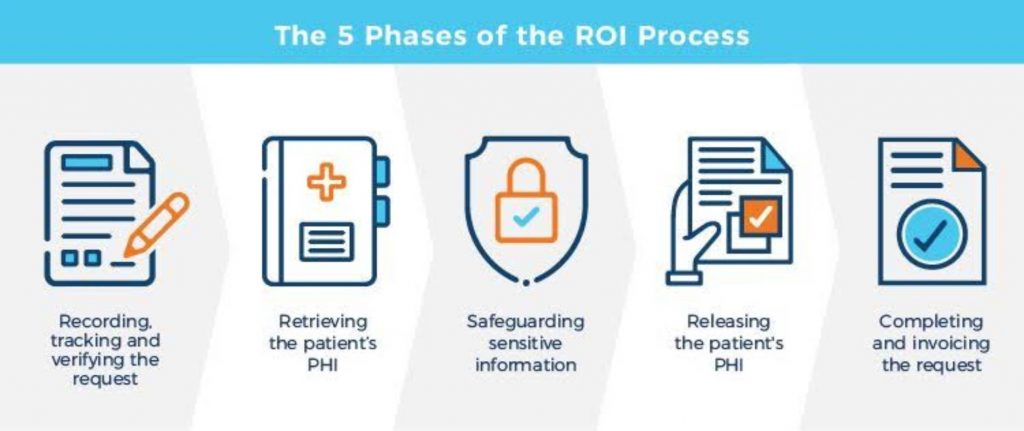Transparency in the flow of medical data is critical to ensuring that patients receive high-quality care at a reasonable price. The data must be complete and up to date to be effective. But, it isn’t always that way in today’s highly regulated medical and legal landscape.
Continuity of patient treatment depends on the timely release of patient information (ROI). Also, billing, reporting, research, and other functions rely on it.
The release of protected health information is regulated by a wide range of laws and regulations. Healthcare providers are required by the Health Insurance Portability and Accountability Act of 1996 (HIPAA) to protect individuals’ privacy by implementing specified requirements for handling health information.
Here’s what happens when you seek your medical records:
According to the Association of Health Information Outsourcing Services (AHIOS), there are five phases to the Release Of Information workflow process.
Table of Contents
Phase 1: Keeping Track Of & Confirming The Request
The requester fills out the medical release of information forms or mental health release of information forms. You, the patient, can be the one to make the request. But it could also be an interested party, such as an attorney, insurance firm, or medical research institute. But, the interested party must be authorized first if they aren’t the requester.
If you fill out the ROI form, your medical records can be released to a healthcare provider, such as your local hospital.
As soon as the healthcare organization receives the ROI request, it is instantly recorded by the ROI department. In addition, they verify the legitimacy of the authorization.
Phase 2: Getting Back Your PHI
The medical record number is searched for by an ROI professional. Find out if the file is on hard copy, microfilm, or electronic media. Whether it’s on-site, off-site, or digitally stored is another consideration. In some circumstances, they are required to retrieve data in all three formats from all three types of sites simultaneously.
PHI is extracted from your medical records and uploaded to the release of information software with the medical records in hand. If they can’t find your medical records, they’ll let you know by making a note in the tracking system.
Phase 3: Protecting Your Personal Data
The ROI expert meticulously scrutinizes each image or page, so do not include any health information that is either state or nationally protected. In case of rejections, an update is made to their software if it does not comply with their policies.
Consequentially, the ROI specialist checks to ensure that all of the pages and photos are part of your file, not someone else’s. They also verify that the service dates are accurate.
After that, they scan a copy of the request and authorization into the tracking program as a backup. The medical records also check in any hard-copy documents and photos. After that, they put the hard copy chart back together and store it.
Phase 4: Unloading Your PHI
The ROI professional checks the request against the database to verify that the data is yours. Your social security number and date of birth are used to authenticate your identity. They also consult the diagnostic to ensure the therapy information they’re disseminating is accurate.
The ROI department conducts a quality review to ensure that the correct PHI is included. This signifies that another ROI expert has confirmed that the records are of the right type and date range. Aside from that, they make sure that the documents are in the correct order.
Phase 5: Completion Of The Request & Preparation Of An Invoice
The ROI expert does one final review of the data in the process’s closing stages. They use the pricing set out in state statutes to arrive at a price and create an invoice. As soon as everything is ready, they’ll put it all in an envelope and mail it to you.
Email or a secure, encrypted web platform can also be used to convey the documents to you.
Significant Challenges: Release Of Patient Information
All health information management (HIM) departments must fulfill the release of information (ROI) function. Nonetheless, the ROI process is risky and complicated. Healthcare professionals encounter a variety of difficulties when it comes to the release of patient information, including the following:
- Employee training: Ensuring that all employees are adequately trained to adhere to HIPAA laws to maximize return on investment
- Stress: Working with employees who are already stretched to the limit can be stressful
- Risk of litigation: Retrieving information from many EHR systems or working with paper-based data to fulfill ROI demands is risky
- Time pressure: Maintaining regulatory compliance while meeting the fast turnaround times for requests and the regular information audits that go along with them
Although these difficulties can be overwhelming, they can be made more accessible, faster, and less complex with the proper procedures and practices.
Conclusion
The release of information is typically riddled with questions and requires a review before it can be fulfilled. Finding the right balance between protecting patient privacy, adhering to regulatory requirements, and providing high-quality care is the most challenging issue for HIM professionals. The HIM professional’s knowledge and expertise maintain the delicate balance between the two.
It’s smart management practice to keep an eye on ROI methods and the quality of work completed regularly, regardless of whether such processes are handled internally or by a subcontractor.
An organization can’t determine if its rules and procedures are effective without conducting a regular checkup. Specific tasks can be performed to assure acceptable and compliant performance, but there is no “cookie-cutter” solution.


